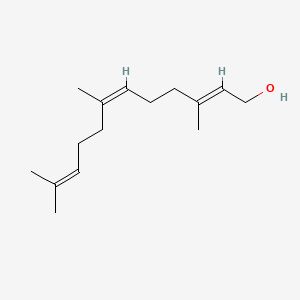| MeSH term | MeSH ID | Detail |
|---|---|---|
| Cell Transformation, Neoplastic | D002471 | 126 associated lipids |
| Thyroid Neoplasms | D013964 | 33 associated lipids |
| Carcinoma, Hepatocellular | D006528 | 140 associated lipids |
| Fibrosis | D005355 | 23 associated lipids |
| Leukemia, Myeloid, Acute | D015470 | 19 associated lipids |
| Hypergammaglobulinemia | D006942 | 9 associated lipids |
| Glioblastoma | D005909 | 27 associated lipids |
| Nephritis | D009393 | 19 associated lipids |
| HIV Infections | D015658 | 20 associated lipids |
| Neurilemmoma | D009442 | 10 associated lipids |
(e,z)-farnesol
(e,z)-farnesol is a lipid of Prenol Lipids (PR) class.
Cross Reference
There are no associated biomedical information in the current reference collection.
Current reference collection contains 3613 references associated with (e,z)-farnesol in LipidPedia. Due to lack of full text of references or no associated biomedical terms are recognized in our current text-mining method, we cannot extract any biomedical terms related to diseases, pathways, locations, functions, genes, lipids, and animal models from the associated reference collection.
Users can download the reference list at the bottom of this page and read the reference manually to find out biomedical information.
Here are additional resources we collected from PubChem and MeSH for (e,z)-farnesol
Possible diseases from mapped MeSH terms on references
We collected disease MeSH terms mapped to the references associated with (e,z)-farnesol
PubChem Biomolecular Interactions and Pathways
All references with (e,z)-farnesol
Download all related citations| Authors | Title | Published | Journal | PubMed Link |
|---|---|---|---|---|
| Andres DA et al. | Rapid identification of cysteine-linked isoprenyl groups by metabolic labeling with [3H]farnesol and [3H]geranylgeraniol. | 1999 | Methods Mol. Biol. | pmid:10399149 |
| Corsini A et al. | Incorporation of radiolabeled prenyl alcohols and their analogs into mammalian cell proteins. A useful tool for studying protein prenylation. | 1999 | Methods Mol. Biol. | pmid:10399150 |
| Hisajima T et al. | Protective effects of farnesol against oral candidiasis in mice. | 2008 | Microbiol. Immunol. | pmid:18667031 |
| Abe S et al. | Suppression of anti-Candida activity of macrophages by a quorum-sensing molecule, farnesol, through induction of oxidative stress. | 2009 | Microbiol. Immunol. | pmid:19493200 |
| Cugini C et al. | Candida albicans-produced farnesol stimulates Pseudomonas quinolone signal production in LasR-defective Pseudomonas aeruginosa strains. | 2010 | Microbiology (Reading, Engl.) | pmid:20656785 |
| Machida K et al. | Farnesol-induced growth inhibition in Saccharomyces cerevisiae by a cell cycle mechanism. | 1999 | Microbiology (Reading, Engl.) | pmid:10075411 |
| Laffey SF and Butler G | Phenotype switching affects biofilm formation by Candida parapsilosis. | 2005 | Microbiology (Reading, Engl.) | pmid:15817776 |
| Gouveia V et al. | Di- and sesquiterpenoids from Cystoseira genus: structure, intra-molecular transformations and biological activity. | 2013 | Mini Rev Med Chem | pmid:23621654 |
| Charron G et al. | Alkynyl-farnesol reporters for detection of protein S-prenylation in cells. | 2011 | Mol Biosyst | pmid:21107478 |
| Kloog Y and Cox AD | RAS inhibitors: potential for cancer therapeutics. | 2000 | Mol Med Today | pmid:11006529 |
| Foster JM et al. | Biosynthesis of isoprenoid compounds in Schistosoma mansoni. | 1993 | Mol. Biochem. Parasitol. | pmid:8264731 |
| Agassandian M et al. | Calcium-calmodulin kinase I cooperatively regulates nucleocytoplasmic shuttling of CCTα by accessing a nuclear export signal. | 2012 | Mol. Biol. Cell | pmid:22621903 |
| Charette N et al. | Salirasib inhibits the growth of hepatocarcinoma cell lines in vitro and tumor growth in vivo through ras and mTOR inhibition. | 2010 | Mol. Cancer | pmid:20860815 |
| Levy R et al. | Galectin-3 promotes chronic activation of K-Ras and differentiation block in malignant thyroid carcinomas. | 2010 | Mol. Cancer Ther. | pmid:20682656 |
| Barkan B et al. | Phenotypic reversion of invasive neurofibromin-deficient schwannoma by FTS: Ras inhibition reduces BMP4/Erk/Smad signaling. | 2011 | Mol. Cancer Ther. | pmid:21632464 |
| Goldberg L et al. | Salirasib (farnesyl thiosalicylic acid) for brain tumor treatment: a convection-enhanced drug delivery study in rats. | 2008 | Mol. Cancer Ther. | pmid:19001442 |
| Zundelevich A et al. | Suppression of lung cancer tumor growth in a nude mouse model by the Ras inhibitor salirasib (farnesylthiosalicylic acid). | 2007 | Mol. Cancer Ther. | pmid:17541036 |
| Blum R et al. | Suppression of survivin expression in glioblastoma cells by the Ras inhibitor farnesylthiosalicylic acid promotes caspase-dependent apoptosis. | 2006 | Mol. Cancer Ther. | pmid:16985068 |
| Ura H et al. | Selective cytotoxicity of farnesylamine to pancreatic carcinoma cells and Ki-ras-transformed fibroblasts. | 1998 | Mol. Carcinog. | pmid:9496909 |
| Stärkel P et al. | Ras inhibition in hepatocarcinoma by S-trans-trans-farnesylthiosalicyclic acid: association of its tumor preventive effect with cell proliferation, cell cycle events, and angiogenesis. | 2012 | Mol. Carcinog. | pmid:21882255 |
